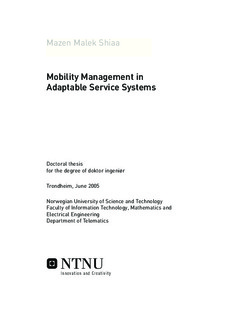| dc.description.abstract | Telecommunication service systems have been developing rapidly during the last five decades. The service architectures as well as the technologies for design, implementation, deployment, execution, and management of the services have been under continuous development. The focus of this thesis is mobility management in adaptable service systems. Adaptable service systems are service systems that adapt dynamically to changes in both time and position related to users, nodes, capabilities, status and changed service requirements and mobility management is the handling of movements of the various components that can potentially move. As examples persons, services, terminals, nodes, capabilities, data and programs can move. Mobility management allows services to find locations, and to deliver certain content to the users or terminals regardless of their location. This thesis is focusing on the movement of persons, services, programs and terminals.
The thesis is related to TAPAS (Telematics Architecture for Playbased Adaptable Service Systems) research project. This project started in 1997 and has been founded by the Norwegian Research Council and the Department of Telematics at NTNU.
The thesis has four main parts: 1) a generic terminology framework, 2) a mobility management architecture, 3) a design model for the basic mechanism used to specify and realize the services, i.e. the role-figure model, and 4) a formal model and analysis of the role-figure model. The terminology framework is the basis for the mobility management architecture. Three main mobility types are handled. These types are personal mobility, role-figure mobility, and terminal mobility. For each of these mobility types a set of generic concepts, definitions, and requirement rules are presented.
The mobility management architecture defines the structure and the functionality of the entities needed to handle the various mobility types. The mobility management architecture is worked out within the context of TAPAS.
The role-figure model is an abstract model for the implemented rolefigure functionality. It has parts such as behaviour, capabilities, interfaces, messages, and executing methods. By using an ODP (Open Distributed Processing) semantic framework and the rewriting logic, the structure of the cooperating role-figures and their behaviour is defined.
This model will be used as the basis for a formal model specified in Maude, which is a language and tool supporting specification and analysis of rewriting logic theories. It is used to reason about the structure and the behaviour of the role-figures and the proposed solution for role-figure mobility. | nb_NO |
